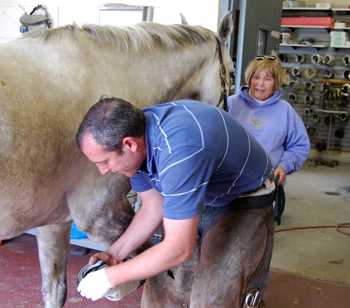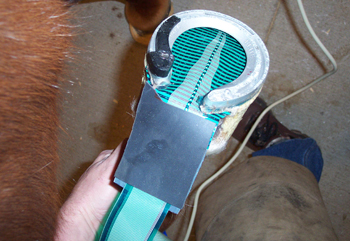 |

|
|
Patrick Reilly applies glue-on shoes to a horse to relieve inflammation in its feet as the owner looks on.
|
An in-shoe force measuring device can track how a horse distributes weight across its foot.
|
Patrick Reilly had been happily shoeing horses for more than a dozen years in New Hampshire when he got some momentous news.
“I had promised my wife 20 years ago that we would never relocate,” he says, “unless I got a call from Penn.”
That call came seven years ago, spurring Reilly to move south to become chief of Farrier Service at Penn Vet. His daily tasks revolve around the creative work of outfitting and caring for horses’ feet.
A narrow definition of a farrier is a person who trims and shoes horses’ hooves, but the history and evolution of the profession is more complex.
The earliest veterinarians were in fact farriers, who practiced their craft while traveling from farm to farm. Their expertise in the anatomy of horses’ feet and lower legs meant that farriers would be called upon to treat minor health issues and injuries.
The anatomy of horses puts them in a somewhat precarious position.
“The best way to explain it is that a horse is walking on a modified fingernail,” Reilly says.
A horse’s overall health is therefore heavily dependent on the soundness of its feet. That is why the work of Reilly and his colleagues at Penn Vet is critical.
Penn is one of just a handful of vet schools in the nation with a working farrier program. And it’s the only school that has a facility to develop new technologies related to farrier science, the Applied Polymer Research Laboratory.
The lab arose from the work of Reilly’s predecessor, Rob Sigafoos. In the 1980s, Sigafoos fashioned a device that some consider the biggest breakthrough in the farrier industry in the last several hundred years: a glue-on horseshoe.
For people unfamiliar with shoeing, the invention may not sound groundbreaking. But, whereas nailing a shoe into the hoof of a horse impairs the hoof’s integrity, a glue-on shoe — which uses fabric to bond the orthotic to the outer surface of the hoof — actually reinforces and strengthens the hoof. Penn holds the patent for the shoe’s design.
“In a very short period of time it’s really become an accepted part of the horseshoeing process,” Reilly says.
He estimates that roughly half of the horses that competed in the Triple Crown donned glue-on shoes.
Now Reilly is building on this innovation, fleshing out a new prototype for the shoe. He’s also capitalizing on human orthopedic technology to study how horses distribute weight across the surface of their hooves.
“One of the things we’re working on is an in-shoe force-measuring system,” he says. “It’s a way of quantifying the forces that are acting on a horse’s foot and trying to solve some arguments, like how are the needs of a race horse different from a jumper.”
Reilly is collaborating with technology company Tekscan to test this technique on his patients. A pilot study on racehorses is also in the works.
“This could give us some insight into how running on grass or dirt or synthetic surfaces changes a horse’s gait,” Reilly says.
With better data, Reilly hopes to identify more effective ways to treat and prevent a scourge for horse owners and veterinarians alike: laminitis.
Laminitis occurs when structures that stabilize the foot become inflamed and painful. A life-threatening condition, laminitis often develops in horses that place excess weight on one or more feet. Using the Tekscan technology, Reilly says, could allow farriers to develop orthotics that help horses distribute weight more evenly across their feet.
As he works toward that goal, Reilly has a full and diverse plate of projects and teaching responsibilities to keep him busy.
“We’ve built prosthetic legs for goats and carbon fiber and Kevlar braces for foals, we’ve shod giraffes and we’ve talked about shoeing elephants and rhinos,” Reilly says. “This is not your typical work environment.”
View videos of the in-shoe force measuring system monitoring horses while trotting: